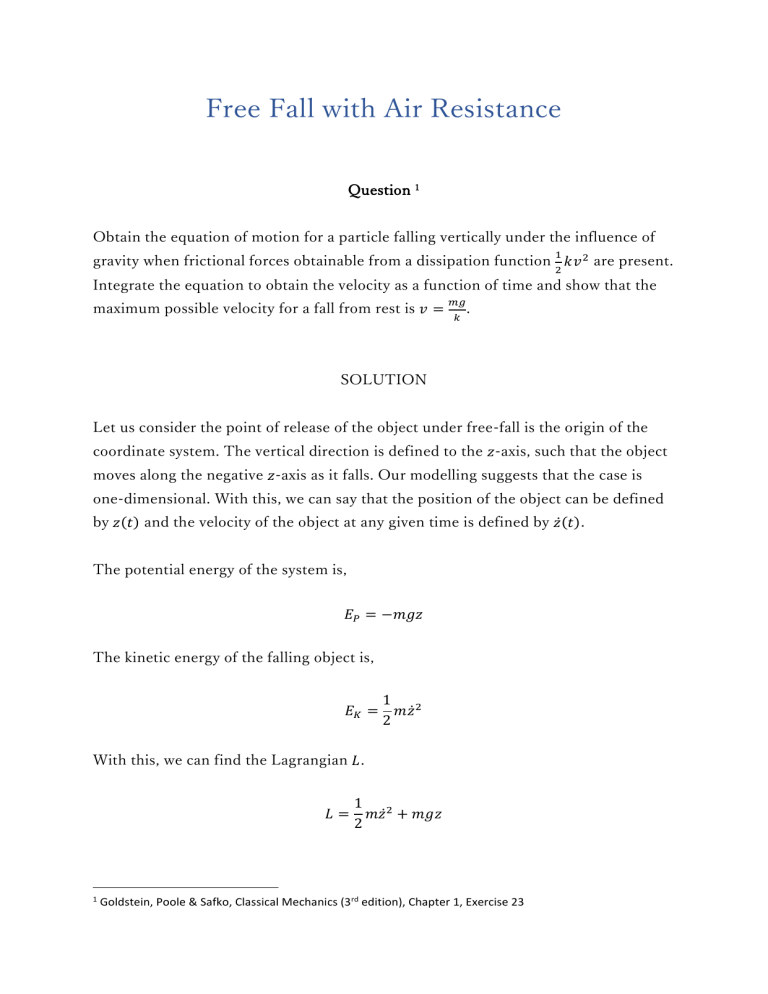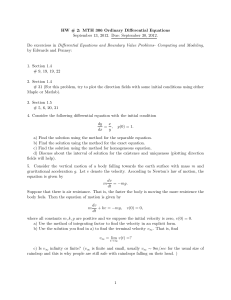
Free Fall with Air Resistance Question 1 Obtain the equation of motion for a particle falling vertically under the influence of 1 gravity when frictional forces obtainable from a dissipation function 𝑘𝑣 2 are present. 2 Integrate the equation to obtain the velocity as a function of time and show that the maximum possible velocity for a fall from rest is 𝑣 = 𝑚𝑔 𝑘 . SOLUTION Let us consider the point of release of the object under free-fall is the origin of the coordinate system. The vertical direction is defined to the 𝑧-axis, such that the object moves along the negative 𝑧-axis as it falls. Our modelling suggests that the case is one-dimensional. With this, we can say that the position of the object can be defined by 𝑧(𝑡) and the velocity of the object at any given time is defined by 𝑧̇ (𝑡). The potential energy of the system is, 𝐸𝑃 = −𝑚𝑔𝑧 The kinetic energy of the falling object is, 𝐸𝐾 = With this, we can find the Lagrangian 𝐿. 1 𝑚𝑧̇ 2 2 1 𝐿 = 𝑚𝑧̇ 2 + 𝑚𝑔𝑧 2 1 Goldstein, Poole & Safko, Classical Mechanics (3rd edition), Chapter 1, Exercise 23 Lagrange’s formalism of equation of motion is given by, 𝑑 𝜕𝐿 𝜕𝐿 𝜕𝑅 ( )− + =0 𝑑𝑡 𝜕𝑧̇ 𝜕𝑧 𝜕𝑧̇ Now, we find each term separately, for the sake of simplicity. 𝜕𝐿 = 𝑚𝑧̇ 𝜕𝑧̇ 𝑑 𝜕𝐿 ( ) = 𝑚𝑧̈ 𝑑𝑡 𝜕𝑧̇ 𝜕𝐿 = 𝑚𝑔 𝜕𝑧 1 The dissipation function 𝑅 is given to be 𝑅 = 𝑘𝑣 2 . 2 𝜕𝑅 = 𝑘𝑧̇ 𝜕𝑧̇ Now, we can find the Lagrangian equation of motion for the system. 𝑚𝑧̈ − 𝑚𝑔 + 𝑘𝑧̇ = 0 𝑚𝑧̈ + 𝑘𝑧̇ = 𝑚𝑔 The equation above is the Lagrangian equation of motion for the system. We can find the velocity function of the object if we solve the differential equation in 𝑧̇ (instead of 𝑧). 𝑘 𝑑 𝑧̇ + 𝑧̇ = 𝑔 𝑚 𝑑𝑡 𝑘 We introduce a constant 𝜔 such that 𝜔2 = . So, we can write, 𝑚 𝑑 𝑧̇ + 𝜔2 𝑧̇ = 𝑔 𝑑𝑡 This is a first order ordinary differential equation. The integrating factor is 𝑒 ∫ 𝜔 𝑒 𝜔2𝑡 . Therefore, 𝑒𝜔 2𝑡 𝑑 2 2 𝑧̇ + 𝜔2 𝑒 𝜔 𝑡 𝑧̇ = 𝑔𝑒 𝜔 𝑡 𝑑𝑡 𝑑 𝜔2𝑡 2 (𝑒 𝑧̇ ) = 𝑔𝑒 𝜔 𝑡 𝑑𝑡 2 2 𝑒 𝜔 𝑡 𝑧̇ = 𝑔 ∫ 𝑒 𝜔 𝑡 𝑑𝑡 2 𝑒 𝜔 𝑡 𝑧̇ = 𝑧̇ = 𝑧̇ = 𝑔 𝜔2𝑡 𝑒 +𝐶 𝜔2 𝐶 𝑔 + 𝜔2𝑡 2 𝜔 𝑒 𝑘𝑡 𝑚𝑔 + 𝐶𝑒 − 𝑚 𝑘 Here, 𝐶 is the integration constant. To find it, we need to consider the initial condition. As the object was released from a point, 𝑧̇ (0) = 0. So, we can write, 𝑧̇ (0) = 𝑘×0 𝑚𝑔 + 𝐶𝑒 − 𝑚 𝑘 𝑚𝑔 +𝐶 =0 𝑘 𝐶=− 𝑚𝑔 𝑘 Putting this value for the integration constant in the solution, 𝑧̇ = 𝑧̇ = 𝑚𝑔 𝑚𝑔 −𝑘𝑡 − 𝑒 𝑚 𝑘 𝑘 𝑘𝑡 𝑚𝑔 (1 − 𝑒 − 𝑚 ) 𝑘 This is the particular solution for the velocity of the falling object. 2 𝑑𝑡 = Now, we can find the terminal velocity of the object from this solution. Terminal velocity is reached when 𝑡 → ∞. So, 𝑧̇ 𝑇 = 𝑚𝑔 𝑚𝑔 (1 − 0) = 𝑘 𝑘 So, the maximum possible velocity for a fall from rest is 𝑚𝑔 𝑘 .





